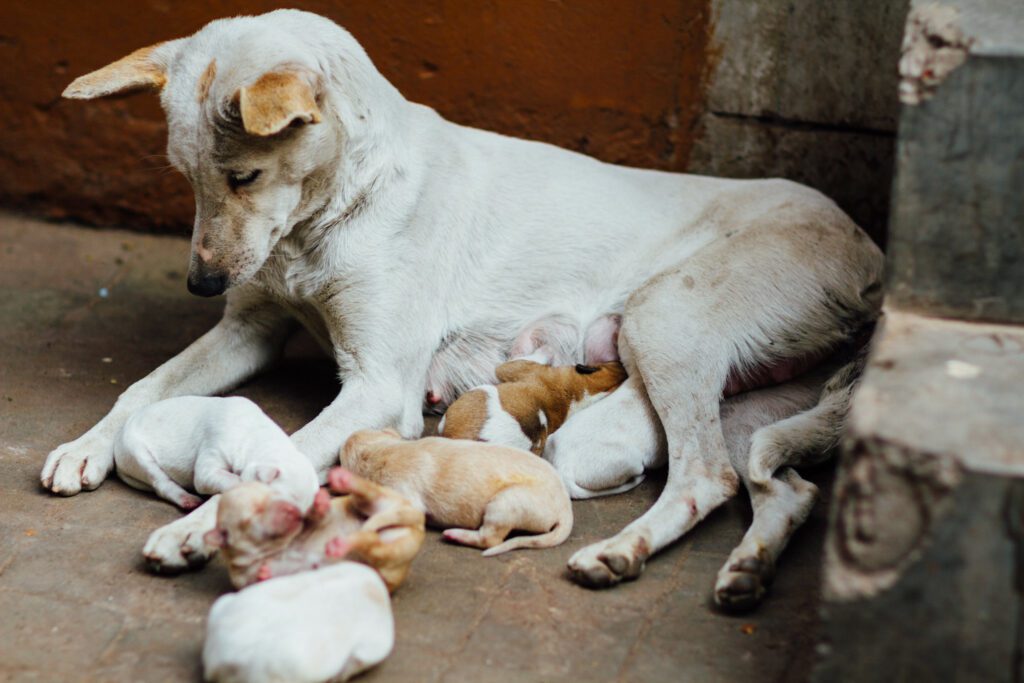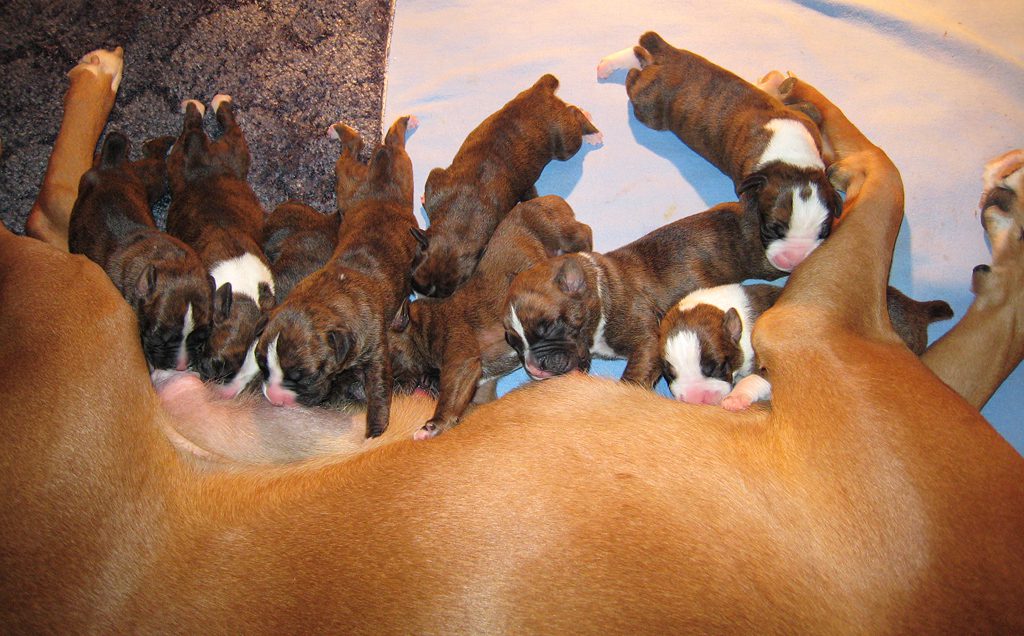As a veterinarian, I often hear from concerned pet owners about their nursing dogs producing excessive milk.
While it’s normal for a mother dog to produce milk to feed her puppies, overproduction can lead to uncomfortable engorgement and even mastitis.
As such, managing milk production is crucial for the well-being of both the nursing mother and her litter.
In this blog post, I will share some tips for managing excessive milk in nursing dogs so that you can ensure your furry family member’s health and comfort.
Causes of Excessive Milk Flow in Nursing Dogs

Nursing dogs producing excessive milk can be a cause of concern for pet owners. Understanding the underlying causes of this issue can help address it more effectively.
Here are some common reasons why nursing dogs produce an excessive amount of milk:
1. Overstimulation of Mammary Glands
One of the most common reasons for excessive milk production is the overstimulation of the mammary glands.
This occurs when the puppies nurse too frequently or for longer than necessary, causing the dog’s body to produce more milk than needed.
Additionally, when puppies are removed from the mother too early, it can lead to excess milk production.
2. Hormonal Imbalances
Hormonal imbalances can also cause excessive milk production in nursing dogs.
Hormones like prolactin and oxytocin play a crucial role in milk production, and imbalances can lead to an overproduction of milk.
3. Inadequate Milk Let-Down
If a nursing dog isn’t experiencing an adequate milk let-down, it can lead to an accumulation of milk in the breasts, causing engorgement and discomfort.
This can happen due to stress, anxiety, or other medical conditions.
4. Breed-Specific Milk Production
Certain dog breeds, like Labradors and Golden Retrievers, are known to produce higher amounts of milk naturally. This breed-specific milk production can lead to excess milk, which may cause discomfort or lead to mastitis.
5. Medications or Medical Conditions
Certain medications and medical conditions can cause an increase in milk production in nursing dogs. Conditions like hypothyroidism and Cushing’s disease, as well as some medications like phenothiazines, can lead to an overproduction of milk.
Understanding the causes of excessive milk flow in nursing dogs is essential for effectively managing the issue. If you notice any signs of discomfort or excessive milk production, it’s best to consult your veterinarian for proper diagnosis and treatment.
See also: How Long Can Newborn Puppies Go Without Nursing?
Signs of Excessive Milk Flow in Nursing Dogs

Excessive milk flow in nursing dogs is a common issue that can lead to discomfort and even health problems.
If you’re a pet owner, it’s important to familiarize yourself with the signs of excessive milk flow in nursing dogs. Here are some common signs to look out for:
1. Swollen Mammary Glands
One of the most common and obvious signs of excessive milk flow in nursing dogs is swollen mammary glands. The mammary glands may appear engorged or even hard to the touch, which can cause pain and discomfort.
2. Leakage of Milk
Another clear sign of excessive milk flow in nursing dogs is milk leakage. If you notice milk leaking from the dog’s nipples, it’s a sure sign that there is an overproduction of milk.
3. Behavioral Changes
Excessive milk flow can also cause behavioral changes in nursing dogs. They may appear restless, moody, or even agitated due to discomfort.
4. Lethargy and Loss of Appetite
In some cases, an overproduction of milk in nursing dogs can lead to lethargy and a loss of appetite. This can be a concerning sign, as it may indicate an underlying health issue.
5. Mastitis
If left untreated, excessive milk flow in nursing dogs can lead to mastitis, a painful inflammation of the mammary gland tissue.
Symptoms of mastitis include swelling, redness, and heat around the affected area, as well as fever and general discomfort.
If you notice any signs of excessive milk flow in your nursing dog, it’s best to consult with your veterinarian.
They can properly diagnose the issue and provide appropriate treatment to ensure the health and comfort of your furry family member.
See also: How To Help a Nursing Mother Dog With Mastitis
Risks of Unmanaged Excessive Milk Flow in Nursing Dogs
Unmanaged excessive milk flow in nursing dogs can lead to various risks and complications. It’s essential to recognize and address this issue as soon as possible to avoid potential health problems.
Here are some of the risks associated with unmanaged excessive milk flow in nursing dogs:
1. Mastitis
Mastitis is a painful and potentially life-threatening inflammation of a nursing dog’s mammary gland tissue. It can occur due to bacterial infection or a blockage caused by excess milk. Mastitis can cause severe pain, fever, and general discomfort in the nursing dog.
2. Milk Fever
Milk fever is a condition that can occur in nursing dogs due to a sudden and drastic drop in calcium levels. It can cause tremors, weakness, and even seizures. This condition can be life-threatening if not treated immediately.
3. Dehydration
Nursing dogs with excessive milk flow may become dehydrated if they don’t consume enough water to replace the fluids lost in milk production. Dehydration can lead to other health problems and further complications.
4. Reduced Milk Quality
Excessive milk flow can lead to a reduced quality of milk, which can have a negative impact on the health of the nursing puppies. This can also lead to a reduced number of nutrients available to the puppies, leading to malnourishment and stunted growth.
5. Behavioral Changes
Unmanaged excessive milk flow can cause behavioral changes in nursing dogs, leading to anxiety, restlessness, and aggression. This can negatively impact the dog’s well-being and the relationship with its owner.
It’s crucial to address excessive milk flow in nursing dogs as soon as possible to avoid these risks and complications. If you observe any signs of excessive milk flow or other issues, consult your veterinarian for proper diagnosis and treatment.
See also: How Often Should Newborn Puppies Nurse?
How To Manage Excessive Milk Flow in Nursing Dogs
Managing excessive milk flow in nursing dogs is essential to ensure their comfort and prevent health complications. Here are some tips on how to manage excessive milk flow in nursing dogs:
1. Limit Nursing Sessions
To prevent overstimulation of the mammary glands, limit nursing sessions to appropriate intervals and duration. Avoid allowing the puppies to nurse excessively or for too long.
2. Cold Compresses
Applying cold compresses to the swollen mammary glands can help reduce inflammation and relieve pain. Use a clean cloth soaked in cold water and wrung out well. Apply it to the affected area for no more than 10 minutes at a time, several times a day.
3. Encourage Fluid Intake
Ensure that the nursing dog has access to fresh water at all times to encourage adequate hydration and help prevent dehydration. Offer low-sodium chicken or beef broth to encourage them to drink more fluids.
4. Medication
In some cases, medications may be necessary to help manage excessive milk flow in nursing dogs. Your veterinarian may prescribe medications like diuretics, antibiotics, or even hormones as needed.
5. Aromatherapy
Aromatherapy can be used to calm the mind and reduce stress in nursing dogs. Lavender or chamomile essential oils can be added to a diffuser or rubbed on the bedding to create a calm and soothing environment.
6. Weaning Puppies
Gradual weaning of the puppies over time is necessary to reduce milk production. This should be done slowly and progressively so as not to cause engorgement of the mammary glands.
Excessive milk flow in nursing dogs can be a challenging issue to manage, but it’s crucial to take the necessary steps to address this problem. It’s best to consult with your veterinarian for proper diagnosis and treatment to ensure that your furry family member remains healthy and comfortable.
How To Prevent Excessive Milk Flow in Nursing Dogs
Preventing excessive milk flow in nursing dogs is an integral part of their overall health and well-being. Here are some tips on how to prevent excessive milk flow in nursing dogs:
1. Breed-Specific Considerations
If your dog belongs to a breed that traditionally has a higher milk production, it’s essential to pay particular attention to the nursing schedule to avoid oversupply.
2. Proper Nutrition
A balanced and nutritious diet can help prevent excessive milk production in nursing dogs. Ensure that the nursing dog gets enough protein and other essential nutrients to support milk production, but not in excess.
3. Avoid Overstimulation of Mammary Glands
Avoid overstimulating the mammary glands by monitoring nursing sessions, keeping them brief, and avoiding letting puppies nurse for too long in one sitting.
4. Gradual Weaning of Puppies
Gradual weaning of the puppies over time can help prevent engorgement of the mammary glands and reduce the likelihood of excessive milk production.
5. Use of Supplements
Some natural supplements such as sage and peppermint may aid in milk reduction and minimize the risk of engorgement of the mammary glands.
6. Clean Environment
Maintain a clean and hygienic environment for nursing dogs and their puppies to reduce the risk of infections that may lead to medical conditions like mastitis.
7. Consult with a Veterinarian
Consult with your veterinarian to ensure your nursing dog is in good health, and there are no underlying medical issues that may cause or worsen excessive milk production.
By taking these steps, you can prevent excessive milk flow in your nursing dog and promote health and comfort for both the dog and her puppies. If you have any concerns, consult your veterinarian for advice and support.
In Conclusion
Managing excessive milk flow in nursing dogs is crucial to ensure their health and well-being. The causes of excessive milk production, the signs of excessive milk flow, and the risks of unmanaged excessive milk flow should be kept in mind by pet owners to ensure their nursing dogs’ safety.
Proper preventative measures, including proper nutrition, limiting nursing sessions, gradual weaning of puppies, and a clean environment, can help prevent excessive milk production in nursing dogs.
If you notice any signs of excessive milk flow or significant changes in your nursing dog’s behavior, contact your veterinarian for proper diagnosis and treatment.
By taking the necessary steps to manage and prevent excessive milk flow, pet owners can help ensure their furry family members remain healthy, happy, and comfortable throughout the nursing process.





Leave a Reply